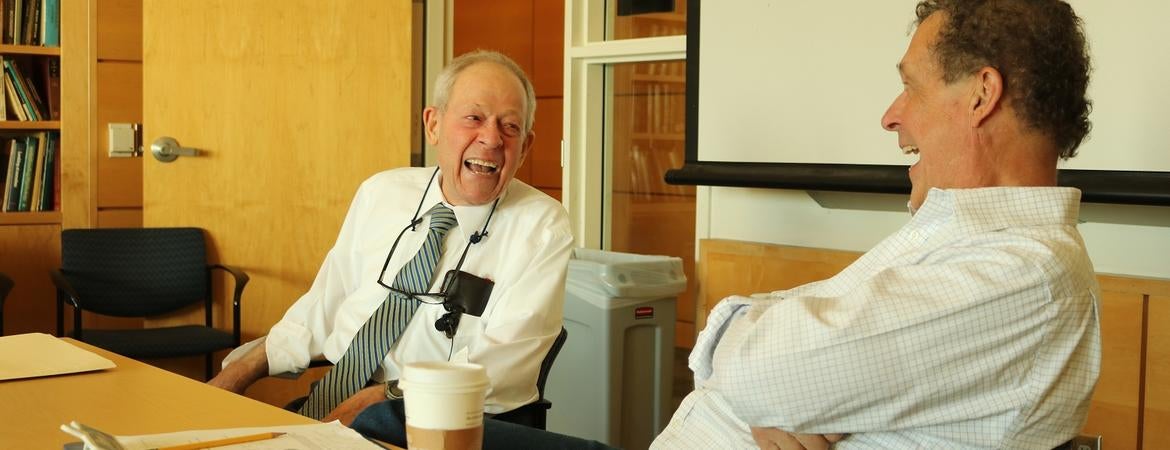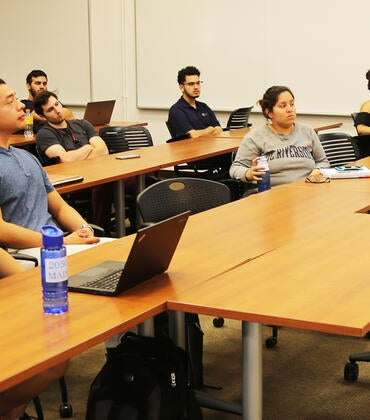
The course is named “Seminar in Social Psychology,” but it could be “Wednesdays with Bob.”
At 85, Robert Rosenthal is in his last year teaching at UC Riverside. Distinguished Professor David Funder — who first worked with Rosenthal at Harvard University in the early 1980s — urged Rosenthal to host a semester-long brain dump. Funder is the emcee, the inquisitor.
Says Rosenthal: “It’s a strange course. It’s a class about me.”
On an afternoon at the beginning of fall quarter, psychology graduate students file into the third-floor library in the psychology building, a wall of windows with shades drawn. They drop their backpacks on the ground, set down their water bottles-of-many-colors.
Funder walks in, opens the blinds, then sits at the front of the room with Rosenthal, who is dressed in a white oxford shirt, tie, and slacks, the work uniform he’s worn since his first job, 65 years ago, at the Grace Fernald School. “Move up,” Funder gestures, when students gravitate toward the cheap seats in the rear.
This is a front-row seat to history.
“I didn’t want to miss the chance of doing this,” Funder says later. “Bob is one of the definitive figures in the history of psychology.”
Behavioral psychology for the masses
2018 is the 50th anniversary of Rosenthal’s seminal work, "Pygmalion in the Classroom," a book that transcended academia to capture popular fascination.
Rosenthal was 35 years old in 1968, tenured the previous year at Harvard. That newfound security vaulted the Rosenthals — Bob, his wife, MaryLu, and children Roberta, David, and Virginia — into a five-bedroom, split-
level home at 12 Phinney Road in Lexington, Mass., 10 miles from campus. He had plugged away on "Pygmalion" rewrites from his basement office, his desk a castaway door laid on top of two filing cabinets.
"Pygmalion in the Classroom" landed him on the front page of The New York Times, and on the Today show with Barbara Walters — he remembers being introduced to Walters’ newborn baby in The Green Room.
The research on which the book is based is among the most widely cited studies in the history of psychology. It’s called one of psychology’s most inspiring books, and one of its most controversial.
The book sprang from a notion that progressively captured Rosenthal’s imagination in the 1960s: self-fulfilling prophecies. It led him to this: “It’s shocking how much teaching is done by teachers who think their students can’t learn.”
He called the phenomena of pre-determined classroom outcomes “The Pygmalion Effect,” after the mythological Greek sculptor whose obsession with the ivory statue of a woman brought her to life.
In the company of giants
To say Robert Rosenthal is among the most influential psychologists in history isn’t hyperbole. It’s science.
Modern psychology was born and matured in the 1900s. The discipline underwent a remarkable transformation in the 20th century, away from the European-influenced philosophical psychology of the late 19th century, to an empirical, research-based American model.
In 2002, “The 100 Most Eminent Psychologists of the 20th Century” was published in the Review of General Psychology. Psychologists of the 1900s were measured on three quantitative variables and three qualitative variables. The quantitative involved journal and textbook citations. The qualitative included membership and leadership positions in esteemed organizations, and awards. From there, a composite score was used to build the rank-ordered list.
Rosenthal is No. 84 on that list, which includes the likes of Sigmund Freud, B.F. Skinner, Ivan Pavlov, and Carl Jung. Scanning the 100, Rosenthal said he met 27 of them; he collaborated with 13. He is one of only 16 still living.
With statistician Gene Glass, he co-founded modern meta-analysis, which transformed scientific research by combining studies to compound probability. He is also among the fathers of psychological principles including experimenter bias and interpersonal expectations.
It’s not name-dropping if they don’t know the name
Rosenthal has an easy, inviting manner, and sprinkles the Wednesday class with anecdotes, stories involving giants of psychology such as Roger Brown (No. 34 on the most eminent list), Herbert Kelman, Paul Meehl (No. 74), and Bill Estes (No. 77). Most are now famous only to psychology scholars.
Stanley Milgram (No. 46) is one of the more recognizable. He’s infamous for his experiments on obedience and authority, in which faux electric shocks of increasing intensity were administered to faux subjects. Milgram also came up with the phrase “degrees of separation,” which asserts one can connect anyone in the world to another person in five steps.
Their first meeting — on the 14th floor of the then-new William James Hall at Harvard — was an auspicious one. Milgram approached Rosenthal, clicked his heels, saluted, and proclaimed, “Heil!” The stunned Rosenthal later figured it out: it was a sign of solidarity among the two Jewish survivors of Nazi occupation.
Rosenthal’s family fled Nazi-occupied Germany in 1938. They lived for a time in Southern Rhodesia, which was then under British Colonial rule, then moved to Queens in New York City.
Five years after the meeting in William James Hall, Harvard knighted Rosenthal with Milgram’s presumed tenure slot. Several years prior, in 1963, Rosenthal had been hired to fill the faculty slot vacated by “turn on, tune in, drop out” Timothy Leary, after the father of psychedelia was fired. He also got Leary’s office.
Experimenter bias: the road to "Pygmalion"
The road to "Pygmalion in the Classroom" was experimenter bias, which is when an experimenter’s expectations are subtly communicated to participants. In the early 1960s, Rosenthal read the report “Youth in the ghetto; a study of the consequences of powerlessness and a blueprint for change,” by Kenneth B. Clark. In it, Clark asserted that teachers had lesser expectations for the poor, black children of Harlem, and didn’t work as hard teaching them.
The study started a chain reaction.
Then at the University of North Dakota, Rosenthal asked a group of lab researchers to experiment with rats that he said were bred to be either good or bad at navigating mazes. The cages were labeled “maze-bright,” and “maze-dull.” In fact, the labels were randomly assigned.
The “maze-bright” rats ran the maze more efficiently and faster, a fact Rosenthal attributed to the keepers’ handling. He wrote about the discovery in a 1963 article in American Scientist: “If rats became brighter when expected to, then it should not be farfetched to think that children could become brighter when expected to by their teachers.”
Lenore Jacobson, the principal of Spruce Elementary School in San Francisco, read the article and wrote Rosenthal: “If you ever ‘graduate’ to classroom children, please let me know whether I can be of assistance.” Rosenthal pounced.
The "Pygmalion" study: highfalutin hijinks, for science
As with many psychology experiments, Rosenthal’s "Pygmalion" study was predicated on a mistruth. The principal, Jacobson, told teachers that Rosenthal had permission to administer an IQ test.
“I wanted something that meant ‘change in intellectual performance,’ but couched in language highfalutin enough to make it sound super-authentic,” Rosenthal said. “I thought Harvard might call it the ‘Harvard Test of Inflected Acquisition,’ so we produced about a thousand copies … and went to work.”
In 1965, the Harvard Test of Inflected Acquisition was given to 18 classrooms, and — soon after — “results” were leaked to teachers: a handful of students in each classroom were poised to excel. But it was smoke and mirrors. The Harvard Test of Inflected Acquisition was a standard IQ test, and the “bloomers” were chosen randomly.
Nonetheless, over the next eight months, the 255 control students gained four IQ points, whereas the 65 designated bloomers gained 12.
Rosenthal’s resulting assertion was revolutionary: it was teachers’ belief in pupils’ potential that led to achievement. As powerful, many of the “bloomers” were from low-income Mexican families. Any student could excel, given the right circumstances.
“The conclusions have great significance for this nation,” the author and child psychiatrist Robert Coles wrote in The New Yorker.
Pushback to "Pygmalion"
The first serious challenge to "Pygmalion" came before it was published.
“It’s garbage!” Lee Cronbach (No. 48 on the most-esteemed list) of Stanford University told the publisher, Holt, Rinehart, and Winston. The publisher asked one of Rosenthal’s colleagues, Donald Campbell (No. 33), to weigh in. “Publish it; it’s great,” Campbell instructed.
“Many educational psychologists hated it. They hated it so much they made a whole book about it,” Rosenthal said.
The book was "Pygmalion Reconsidered; A Case Study in Statistical Inference: Reconsideration of the Rosenthal-Jacobson Data on Teacher Expectancy."
“Pygmalion was enormously controversial,” said Ralph Rosnow, with whom Rosenthal has collaborated on 16 books. “The way education read it was ‘you’re saying there’s something wrong with teachers.’”
In his regular Sunday New York Times column, United Federation of Teachers founder Albert Shanker snarked: “If thousands upon thousands of children are not learning to read, write, speak and compute, it is not because of overcrowded classrooms, the effects of poverty and social conditions, poorly developed educational programs and materials and inadequately trained teachers. No, the children are not learning because the teachers don’t expect them to learn.”
Opined Columbia University’s Robert Thorndike: “Pygmalion is so defective technically that one can only regret that it ever got beyond the eyes of the original investigators!”
Rosenthal armored up with the help of a doctoral student named Don Rubin, who would go on to serve for more than 13 years as chief of Harvard’s Department of Statistics. The "Pygmalion Reconsidered" publishers included the Rosenthal-Rubin rebuttal in an appendix.
“They ran the numbers wrong,” said Rosenthal, who provided the naysayer authors with “huge boxes” filled with IBM cards, which could be fed into room-sized computers. “But I knew my statistician was smarter than their statistician.”
The critics eventually quieted down. Even Cronbach (“It’s garbage!”) became a collaborator, years later. The blooming phenomena became known as “The Pygmalion Effect” and “The Rosenthal Effect.”
Rosenthal’s reluctant revolution
Over the past 50 years, scientists inspired by Rosenthal have tracked The Pygmalion Effect outside of educational settings; in the home, in the workplace — anywhere that leadership can make a difference.
However, the research didn’t transform education in the manner some envisioned. Teachers didn’t end up viewing their pupils as bloomers-in-waiting. One enthusiast referred to "Pygmalion" as “great science that has been underapplied.”
But Rosenthal never intended Pygmalion for a general audience. It was too data-heavy for that, he thought. Its mainstream popularity was an accident.
“I didn’t think of it that way; I had the academic’s view of it,” Rosenthal said. “I wasn’t in it to try to change education, or to be the source of the intervention.”
“Wednesdays with Bob” is now over; the fall quarter has ended. Rosenthal’s attention is drawn to the course number: Psych 255. Two hundred and fifty-five — the number of students in the "Pygmalion" control group. “Isn’t that something,” he muses.
The course number, like the runaway success of his highest-profile work, was just a coincidence.





